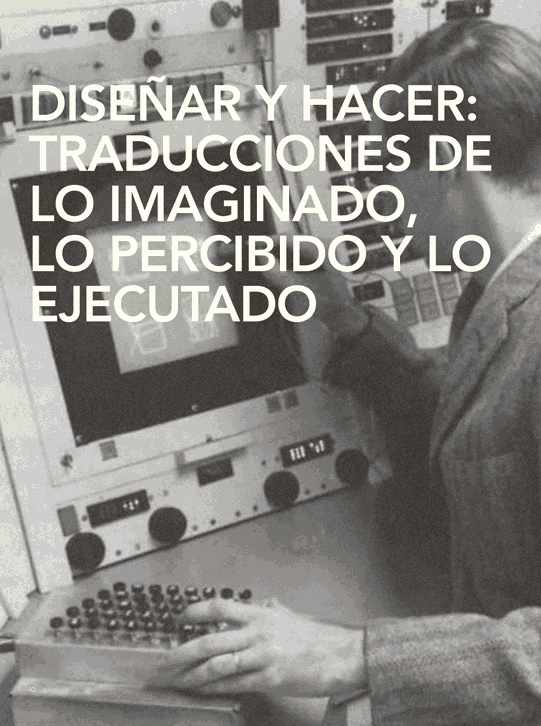Diseñar y hacer: Traducciones de lo imaginado, lo percibido y lo ejecutado
Barra lateral del artículo

Palabras clave:
Contenido principal del artículo
Resumen
Según Schön (1987), el diseño es una forma de arte y de producción, donde el aprender acerca de un tema o diseño específico surge a través de acciones (conscientes o inconscientes) y operaciones heurísticas. El diseñador aprende a diseñar sabiendo y “reflexionando en acción”, reinterpretando y re-elaborando acciones en el momento especial en que tiene lugar el acto de diseñar (Schön, 1987). Esto permite que surjan no sólo nuevos significados y coherencias, sino también la razón y el conocimiento del acto creativo. Este artículo presenta la perspectiva optimista de los primeros proponentes de CAD a comienzos de la década de los sesenta, quienes apoyados por la cibernética y las teorías de la inteligencia artificial, tenían como objetivo principal el desarrollo de “potenciadores de la creatividad”. Esta visión contrasta con el panorama del diseño digital contemporáneo, que discute la relevancia, la pertinencia y el uso actual de lo digital con respecto a lo material. Finalmente, revela aspectos clave de las numerosas interpretaciones de lo imaginado, lo percibido y lo ejecutado, identificando problemas y nuevas alternativas para el uso creativo de lo que actualmente es ubicuo y genérico en términos de destrezas disponibles para los arquitectos.
Abstract
According to Schön (1987), design is a form of artistry and making, where learning about a specific topic or design emerges through actions (conscious and unconscious) and heuristics. The designer learns how to design by knowing and ‘reflecting in action’, reinterpreting and re-elaborating actions in the particular moment where the act of design takes place (Schön, 1987). This allows the emergence of not only new meanings and coherences, but also reason and knowledge about the creative act. This article presents the optimistic perspective of early CAD proponents in the early 60s that, supported by cybernetic and Artificial Intelligence theories, had as main goal the development of ‘creative enhancers’. This vision is contrasted to the contemporary digital design scenario, discussing the relevance, pertinence and current use of the digital towards the material. Finally, it reveals key aspects of the myriad translations between the imagined, the perceived and the executed, identifying problems and new alternatives for the creative use of what today is ubiquitous and generic in terms of skills available for architects.
Detalles del artículo
Materia Arquitectura proporciona acceso inmediato y gratuito a todos los contenidos de esta edición electrónica, publicada simultáneamente con la edición impresa. Materia Arquitectura no cobra honorarios a los autores por ningún concepto.
Todos los contenidos de esta edición electrónica se distribuyen bajo licencia Creative Commons de “Atribución-Copartirigual 4.0 Internacional” (CC-BY-SA).
La licencia Creative Commons permite el acceso libre e inmediato al contenido y permite que cualquier usuario lea, descargue, copie, distribuya, imprima, busque o genere enlaces a los textos completos de los artículos, permitiendo también que estos puedan ser rastreados para indexarlos, pasarlos como datos a software o usarlos para cualquier otro propósito legal. Asimismo, la licencia otorga derechos de uso a quienes a su vez utilicen una licencia abierta (Creative Commons o equivalente).
Los derechos de los textos y las imágenes publicadas pertenecen a sus autores, quienes otorgan a Materia Arquitectura la licencia para su uso. La gestión de los permisos y la autorización de publicación de las imágenes (o de cualquier material) que contenga derechos de autor y sus consecuentes derechos de reproducción en esta publicación es de exclusiva responsabilidad de los autores de los artículos.
Toda vez que mencionen su origen, los autores son libres de distribuir sus artículos por otros medios. Cualquier reproducción total o parcial del material deberá citar su procedencia.
Descargas
Citas
BAZJANAC, V. (1975). The Promises and the Disappointments of Computer-Aided Design. En N. Negroponte (Ed.), Reflections on Computer Aids to Design and Architecture (págs. 17-26). Nueva York, NY, EE.UU.: Petrocelli/Charter.
COONS, S. (1975). Reflections beyond SKETCHPAD. En N. Negroponte (Ed.), Reflections on Computer Aids to Design and Architecture (págs. 27-29). Nueva York, NY, EE.UU.: Petrocelli/Charter.
KOLAREVIC, B. (Ed.). (2003). Introduction. En B. Kolarevic (Ed.), Architecture in the digital age: Design and manufacturing (págs. 1-16). Nueva York, NY, EE.UU.: Spon Press.
MILNE, M. (1975). Whatever Became Of Design Methodology? En N. Negroponte (Ed.), Reflections on Computer Aids to Design and Architecture (págs. 30-36). Nueva York, NY, EE.UU.: Petrocelli/Charter.
NEGROPONTE, N. (1975). Introduction. En N. Negroponte (Ed.), Reflections on Computer Aids to Design and Architecture (págs. 1-13). Nueva York, NY, EE.UU.: Petrocelli/Charter.
OXMAN, R. (2006). Theory and design in the first digital age. Design Studies, 27(3), 229–265.
ROBINSON, D. (2013). Feeling extended: Sociality as extended body-becoming-mind. Cambridge, MA, EE.UU.: MIT Press.
SCHÖN, D. A. (1987). Educating the reflective practitioner. San Francisco, CA, EE.UU.: Jossey-Bass.
SUTHERLAND, I. (1975). Structure in drawings and the hidden surface problem. En N. Negroponte (Ed.), Reflections on Computer Aids to Design and Architecture (págs. 73-77). Nueva York, NY, EE.UU.: Petrocelli/Charter.
VISSER, W. (2006). The cognitive artifacts of designing. Mahwah, NJ, EE.UU.: L. Erlbaum Associates.
Artículos más leídos del mismo autor/a
- Diego Pinochet, Design and Make: Translations between the Imagined, the Perceived and the Executed , Materia Arquitectura: Núm. 13 (2016): Materia Arquitectura 13 (Agosto/August 2016)